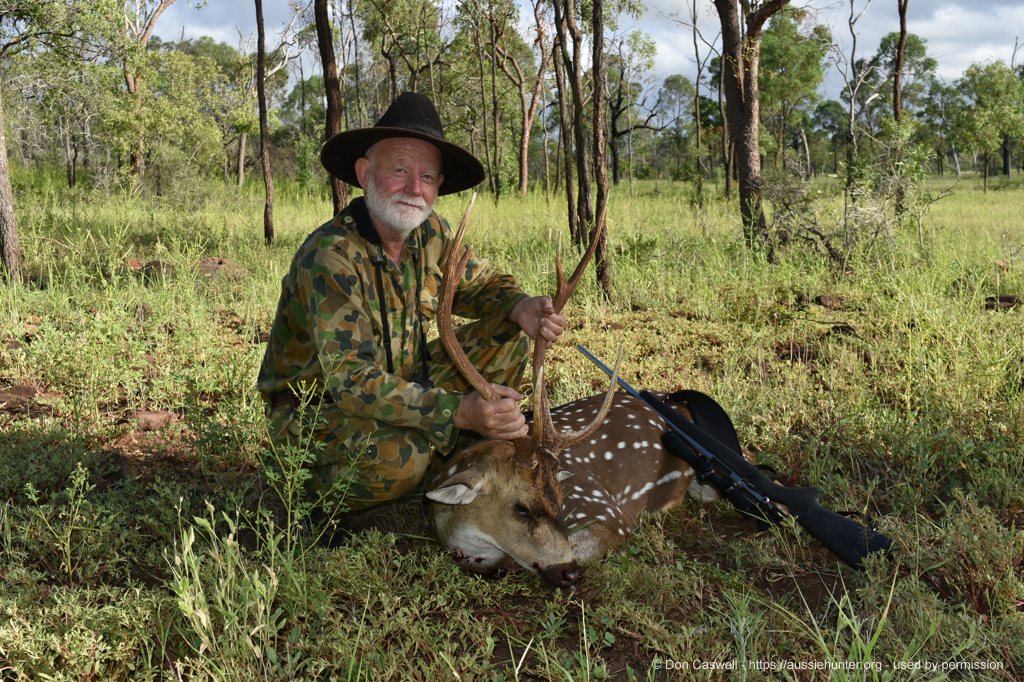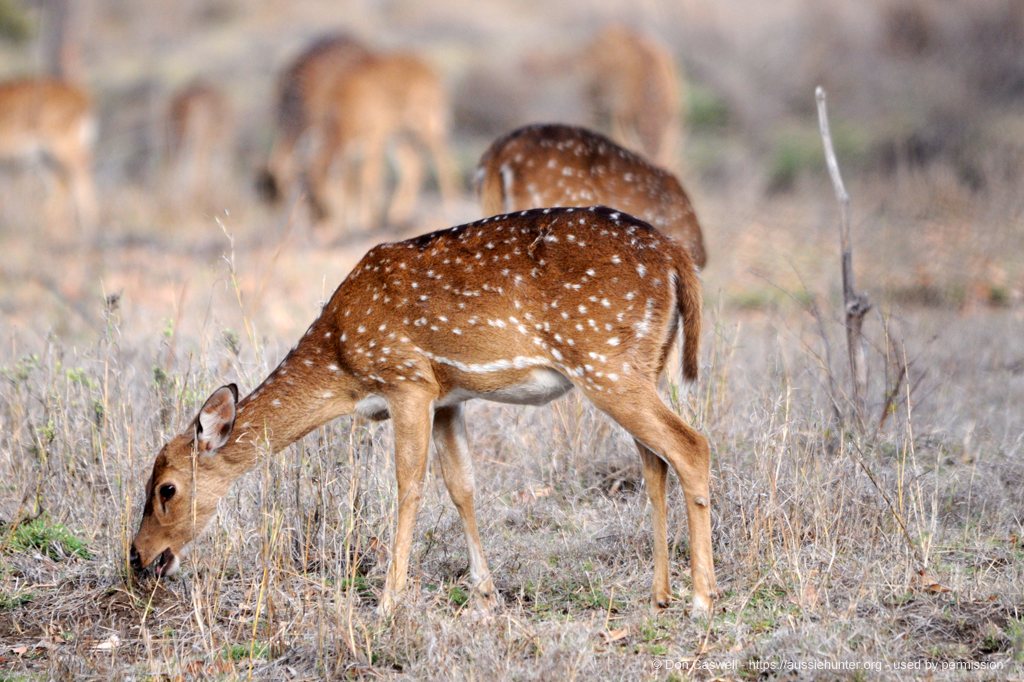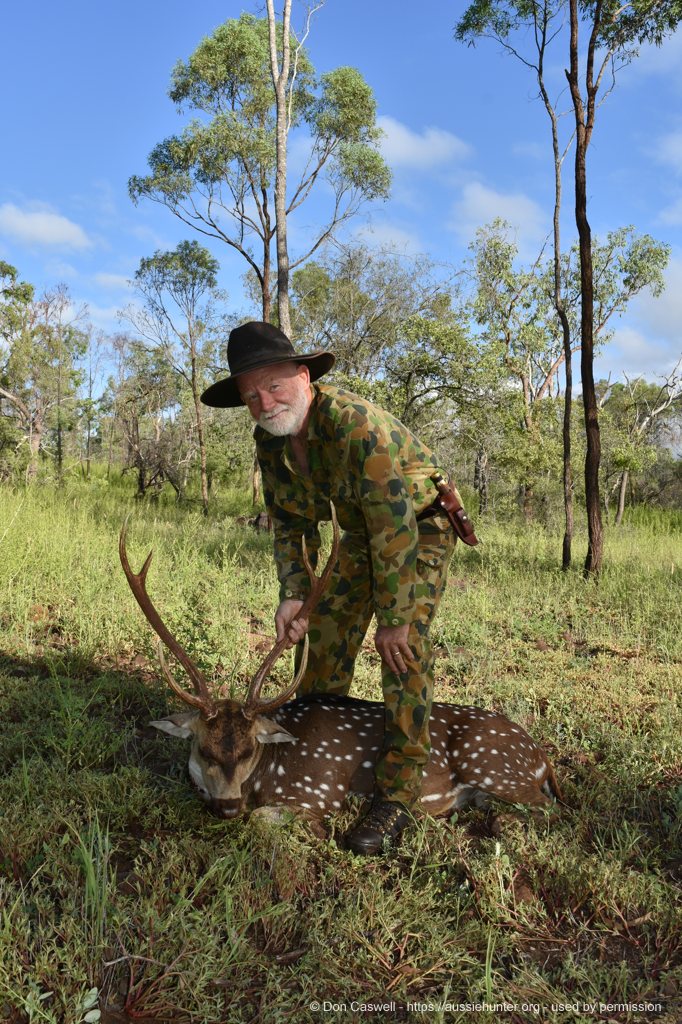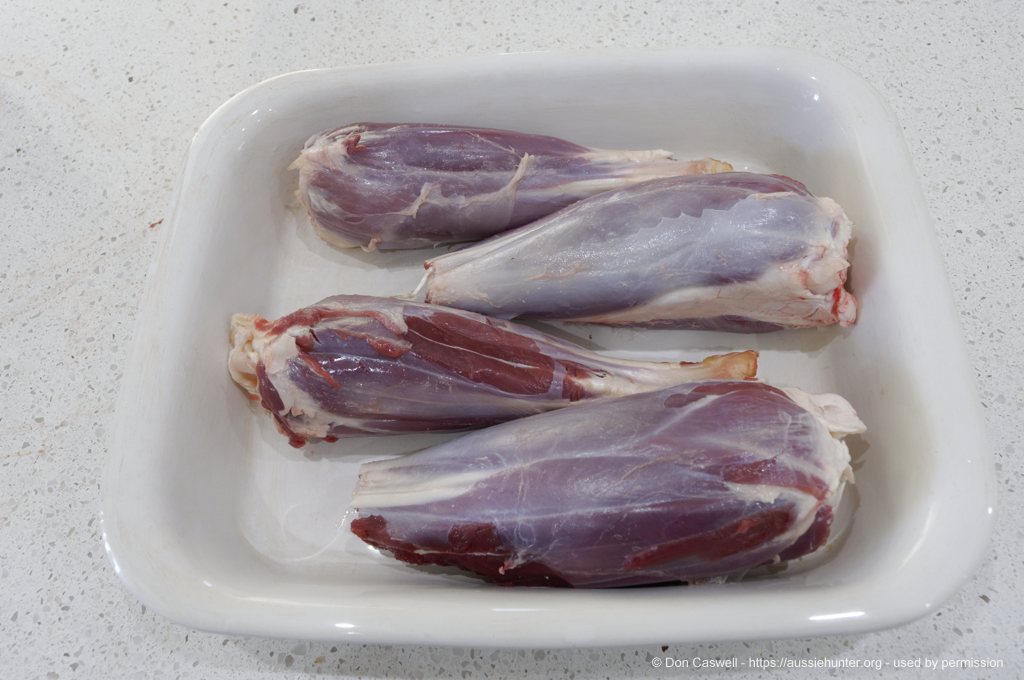
Something had moved in the early morning stillness on the forested ridge. I caught only a fleeting glimpse, a hint of a flicker, as I scanned the bush ahead. My eyes had moved on before it even registered. It may have only been a bird, but my impression was that of an ear flick. I remained frozen and, slowly, brought the 10x25 Swarovski stalking binoculars up to my eyes.
I was stalking a couple of kilometres of low, stony ridge that overlooked a number of huge, circular, irrigated pastures. The property ran beef cattle but also produced a lot of hay and silage. The irrigated land had been fenced in an effort to exclude the cattle, roos, pigs and deer that would relish a feed of the lush green fodder within. The fence had proven successful at keeping out everything, except the resident Chital Deer. A few times each year I visit for a few days and cull some deer. The survivors flee the area and give the cultivation a rest for a while.

My preferred approach is to start where the ridge runs right down to the cultivation fence. I always camp about half a kilometre away, down on the river flats. In the predawn darkness I walk up to the cultivation. My rifle is either a 223 Remington, firing 60 grain Nosler Partition handloads, or my 257 Weatherby Magnum firing 100 grain factory loads or 110 grain Nosler Accubond handloads. Around my neck are my binoculars. On my belt is a knife, a pouch with a few spare rounds of ammo and my rangefinder. I also have a backpack with a water bottle, small survival kit, spare knife, diamond steel, a pack of disposable latex gloves, hand sanitiser and a bunch of large plastic bags for the meat.
Putting the cultivation behind me, I begin a slow and cautious stalk up onto the ridge itself. The ridge is covered in open forest. I begin the stalk as soon as there is enough light to shoot by, well before the actual sunrise. Sometimes I have success without having to actually walk up the ridge at all, if a mob of Chital are a bit late in leaving the irrigation. In those cases I pick my target from the line of deer following a well-worn path up onto the ridge. While it is always nice to get an easy one, I am not disappointed if the deer have already moved up onto the ridge. I simply love the opportunity to stalk them on the plateau. It is one of my favourite hunting activities.
The ridge seems to play host to at least six distinct mobs of Chital. These groups range in number from half a dozen up to thirty animals at times. Having left the pasture and adjacent river flats before daylight fully breaks, they camp up for the day in patches of shady scrub on the ridge. The location of the ridge lends itself to morning stalking. The sun will rise behind me while the breeze, when it picks up, will be coming from the direction I am walking. Chital are a very wary animal with great senses and you have to be right on your game to surprise them.

Stalking the ridge is a slow process. Given that the deer may well be within a hundred metres, full concentration is needed right from the start. I walk only five or ten metres then stop. I look carefully and slowly all about me, before repeating the scan with my stalking binoculars. After some minutes, carefully picking my steps in an effort to be as stealthy as possible, I again move forward then repeat the surveillance. It can take a couple of hours to travel a kilometre through the plateau’s open forest this way. But, it pays dividends.
I was sure that I had detected an ear flick in a patch of scrub about 150 metres ahead. Having slowly brought the binoculars to eye I peered at that patch of bush. I could see nothing initially, but that did not disappoint me as I now have enough experience to know that the first look does not always reveal the truth. As I tracked the binoculars back and forth over about thirty metres of the bush there was suddenly a deer in my sight picture. It had been there all along, but the wonderful spotted coat and coloration of the Chital hind had blended it seamlessly into the background.
It was staring fixedly right in my direction. She was not alarmed, but had clearly heard or seen something and gone on alert. If the old girl had scented, or gotten a good look at me, she would have yelped a warning and all I would have seen would have been the white rumps of the deer disappearing at speed. As I looked at the hind through my binoculars there was a movement beside it. An accompanying yearling had flicked its ear and now I could see it clearly. I spent a good five minutes, maybe longer, studying that patch of scrub. One by one the deer resolved themselves and I could see that there were at least a dozen Chital camped up there. The doe and yearling, and another doe, were standing and keeping sentry while the rest of the deer were laid up on the ground.
The doe was still staring fixedly in my direction. Every now and then she rotated her ears and tilted her slightly, trying hard to determine just what it was that had caught her attention. I had to stand still. If I moved she would pick me up for sure, sound the alarm and scatter her companions. The stalemate continued for what seemed like an interminable time. I did not hear her call, but the doe began to move and the resting animals got to their feet and also began to move off. They were just walking, not running. The doe kept looking back in my direction. When she looked away, I stepped sideways, chambered a round and sighted in on a plump, healthy looking yearling.

The doe had seen me move and her yelp of alarm coincided with my shot. The yearling flopped over. As is often the case, the dominant stag had been secreted close by. He burst out of concealment and I had a brief glimpse of some impressive sized antlers before he disappeared into the bush. One deer was enough for me to process anyway. I took off my backpack and laid out my kit close at hand. It did not take long to break the carcass down. I took the back straps, thighs, front shoulders and all the shanks, leaving only the torso and neck.
Each cut I bagged and tied off to keep flies and dirt away from the meat. The back pack was filled with meat and I carried the shanks separately in their plastic bags. Deer shanks are just as good as lamb shanks when slowly cooked. Loaded up with meat, I cautiously picked my way down the rocky, steep escarpment then set off the kilometre or so to camp.
It was only early morning, but pretty warm already as a northern Queensland summer’s day began to roll out. Stalking, despite being a slow and measured progress through the bush, is a demanding activity. Part of that is the muscle strain required to move slowly and freeze for lengthy periods of time when required. The level of focus and concentration is substantial and can leave you feeling mentally drained at the end of a couple of hours, particularly on those occasions when you have not bagged a deer.
I kicked off my hiking boots and flopped into a camp chair to absorb a much needed, big cup of strong, brewed black coffee. Max, my hunting buddy’s detector dog in training, came over and pushed his head in under my hand for a bit of attention, and reassurance. During an idle moment he had torn my old Dryzabone coat to bits and, even though we had not punished him, Max knew full well he had been naughty. In his own puppy way he was still apologising for that episode. Max’s master, my hunting buddy Mike, had been hunting another ridge and had grassed a plump young stag. After breakfast, and a swim in the river, we would take our bagged meat over to the property homestead where we had been given access to the large chiller room. Apart from having plenty of meat for ourselves we had also trimmed up and bagged some select cuts for our hosts. They enjoyed venison too, but in working dawn to dark they rarely had the time to spare to do any hunting themselves.
Fact Box – Chital Deer
Location
Chital, sometimes spelt Cheetal, are also known as Axis or Spotted Deer. Their natural range was the Indian subcontinent and Sri Lanka (formerly Ceylon). Chital have been introduced to a number of other countries. They were the first deer to be introduced into Australia. That original introduction was onto the lands of the Surgeon to the New South Wales Corps, Dr. John Harris in the early 1800s. Those deer did well initially and were reported to be in excess of 400 by 1813, however they eventually died out.
The most successful release was in the Charters Towers area of North Queensland where Chital were introduced in 1886. Those deer are thriving and have extended their range into other parts of central Queensland. There are also substantial numbers in northern NSW. The great similarity between the climate and terrain of India and Australia accounts for the success of Chital’s adaption to our continent.
Size and Weight
A midsized deer, male Chital typically stand about 900mm at the shoulder and weigh up to about 90kg, but occasionally can exceed 100kg. The stags’ antlers have three points each side and a total antler length of about 900mm in particularly good specimens. The world record length of Chital antler is 1,118mm. Broken tines, from jousting, are common. The female Chital stand about 700mm at the shoulder and normally weigh up to about 45kg, occasionally exceeding 50kg.
Breeding Season
Chital, being a tropical species, do not have the distinct rut and breeding season seen in other species, such as Red Deer. Chital breed throughout the year and, likewise, stags can be seen in full hard antler, in velvet and shed of antlers at any particular point of time. The gestation period is about eight months and a single fawn is the norm.
Behaviour
Chital mostly graze on grasses but will also browse for leaves and fruits. The stags will stand on their hind legs and use their antlers to shake down fruit such as shiny apple. In times of drought most of their food comes from browsing and they will resort to eating even the unpalatable, and poisonous, castor oil bush leaves under duress. They camp up during the heat of the day, feeding early and late. It is common to find them moving to their rest areas at first light. In areas with increased hunting pressure they will become more nocturnal.
Chital are social creatures and readily form mixed herds ranging from a few individuals to gatherings of more than a hundred. They have well honed senses of hearing and smell and excellent vision to boot. Their beautifully patterned coats provide wonderful camouflage in the bush and light forests where they dwell. In any gathering of feeding, drinking or resting animals there will always be one or more sentries on alert, making them a particularly challenging deer to stalk.
Venison
The meat from Chital, even mature stags, is excellent, being fine textured and quite mild. There is not the gaminess that you get in Red Deer venison, for example.
https://vps.westernhunting.com.au/chital-deer-hunting#sigProId4034a3277f





